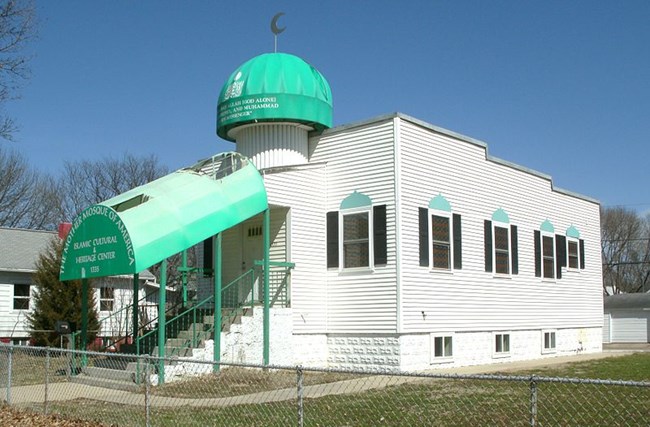Last updated: July 18, 2024
Article
Iowa: The Mother Mosque of America

Image Courtesy of the Rifeideas, Wikimedia Commons
Though commonly suggested, immigrant Muslims were not the first Muslim arrivals in the United States. The first documented Muslim was Estevancio, a North African Muslim captive. He arrived with the Panfilo de Narvaez expedition in 1527. He later would transform our knowledge of the American southwest. Scholars argue that Muslim immigration happened in three phases: 1878-1924, 1952, 1965. These three phases only document immigrant Arab Muslims. The first true wave of Muslims in the United States were brought on cargo ships as slaves. It is estimated that 10 to 40 percent of the enslaved African population was Muslims. This equates to 600,000 to 1.2 million individuals. Though African Muslims left no self-sustaining communities, their history and legacy lives within the Black Nationalist movements of the late 19th and early 20th centuries.
Before the Civil War, Muslim immigration was sparse due to existing laws governing U.S. citizenship. The Naturalization Act of 1790 stipulated that only free white of good moral character could become citizens. This discouraged dark-skined Arab, Indian, and African Muslims from immigrating. This act was Congress' first attempt to set immigration policy. By the 1830s, nativism arose. This is an intense opposition to an internal minority on the grounds of its un-American beliefs. Laws during this period were not specific to Islam as a minority religion, but to their foreign-non-whiteness. Most of these laws were directed toward Chinese and Japanese immigrants.
By the late 1870s, immigrants from the Middle East began entering the United States. Coming from what is now Syria, Jordan, Palestine, and Lebanon, these immigrants were classified as "Turks". At this time "Turks" were considered to be Asiatic and were ineligible to become citizens. Many of the immigrants were poor laborers seeking greater economic stability. A great number of them became disenchanted and returned home. Those who remained became miners, factory workers, peddlers, grocers, shopkeepers, or petty merchants. Though they only represented 10 percent of the Arab immigrants, sizeable clusters of Arab Muslims settled in the mid-west. Until 1924, the flow of Arab immigrants increased as political conditions changed in the Ottoman Empire.
Cut off by language, custom, race and religion, Arab Muslim immigrants, sought a house of worship. The Arab Muslim population in Cedar Rapids, Iowa numbered 45 in 1914. Before long there was a full-scale Muslim community. By the mid-1920s, Cedar Rapids had over 50 shops and grocery stores. In 1925, a group known as 'The Rose of Fraternity Lodge" rented a building to be used as a temporary mosque. Each Friday, 20 young men gathered in the space and began making plans for their own building. Just as the the U.S. was entering the Great Depression, the community set their plan to construct a mosque in motion. Community members completed most of the construction themselves. On Feburary 15, 1934 the building opened its door for the very first time, serving as both a mosque and social center.
The congregation that attended services here became an important force for changing the status of Muslims in the United States. Donations from the Aossey family led to the foundation of the first Muslim National Cemetery in Cedar Rapids in 1948. The cemetery served as a final resting place for the whole mid-west region. Years later, Abdallah Ingram gained recognition for Islam as a valid religion in the U.S. military. This meant that Muslims would no longer be buried as atheists. Members also were among the founding organizers of the Federation of Islamic Associations of the United States and Canada.
By 1970, the community had outgrown the small building. A new mosque was built on First Avenue SW in Cedar Rapids. By the 1980s the building had been sold and served various functions until it fell into a state of neglect and disrepair. The Islamic Council of Iowa purchased the building and renovated in the the early 1990s. Today, it serves again as a place of worship and as a resource center for information about Islam and the history of Muslims in America.
The Mother Mosque of America is located at 1335 9th St. NW, Cedar Rapids, Iowa 52405. It was listed on the National Register of Historic Places on May 15, 1996. For more information about visiting, please call (319) 366-3150 or visit their website.
Tags
- travel americas diverse cultures travel itinerary
- religious diversity
- national register of historic places
- islam
- muslim
- islamic heritage
- nr
- nrhp
- mosques
- mosque
- muslim heritage
- religious freedom
- religious discrimination
- islamic history
- muslim history
- immigration
- mother mosque of america
- the moslem temple
